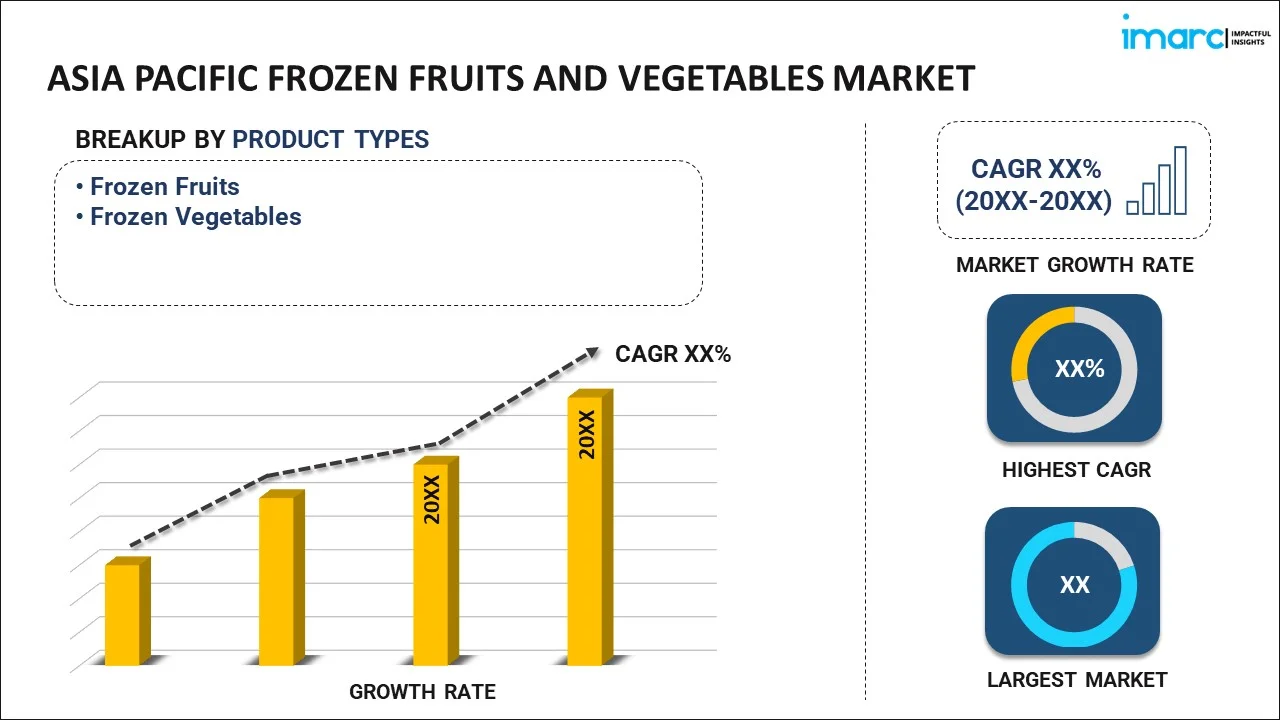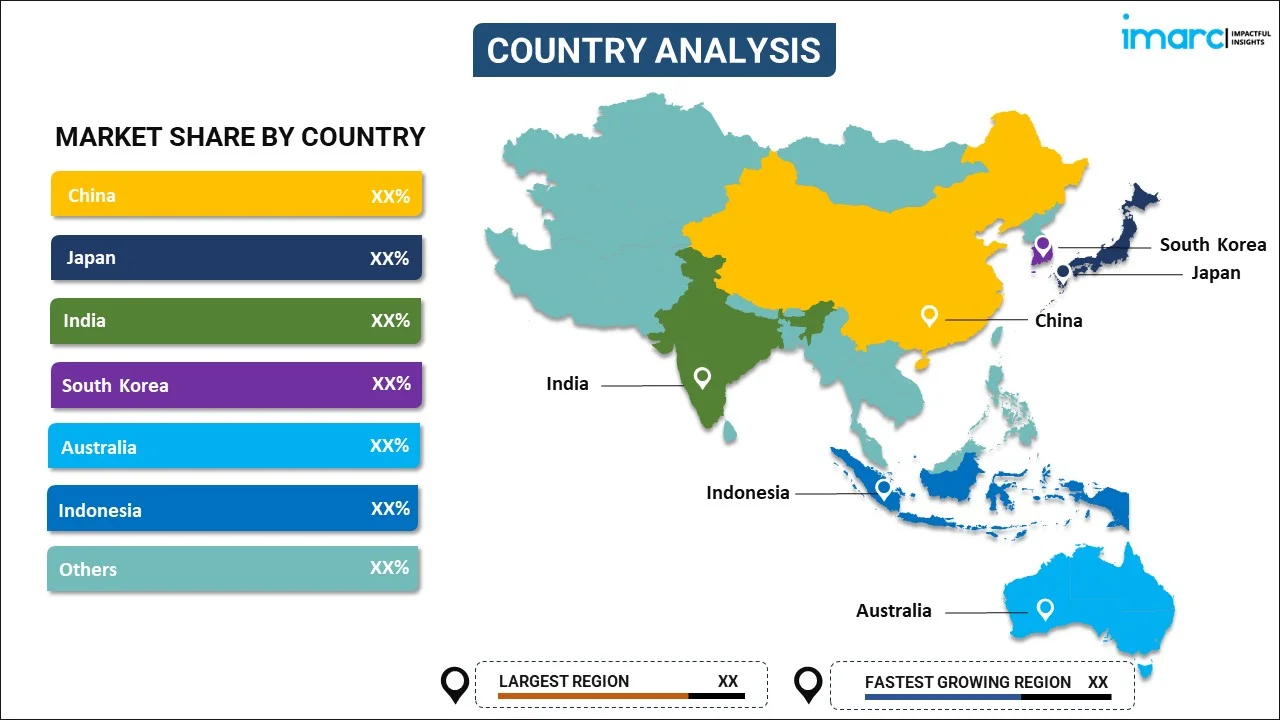
Asia Pacific Frozen Fruits and Vegetables Market Report by Product Type (Frozen Fruits, Frozen Vegetables), Distribution Channel (Supermarkets and Hypermarkets, Independent Retailers, Convenience Stores, Online, and Others), and Country 2025-2033
Market Overview:
The Asia Pacific frozen fruits and vegetables market size reached USD 1.7 Billion in 2024. Looking forward, IMARC Group expects the market to reach USD 2.7 Billion by 2033, exhibiting a growth rate (CAGR) of 4.98% during 2025-2033.
|
Report Attribute
|
Key Statistics
|
|---|---|
|
Base Year
|
2024
|
|
Forecast Years
|
2025-2033
|
|
Historical Years
|
2019-2024
|
|
Market Size in 2024
|
USD 1.7 Billion |
|
Market Forecast in 2033
|
USD 2.7 Billion |
| Market Growth Rate 2025-2033 | 4.98% |
Frozen fruits and vegetables are preserved using various techniques, like machine freezers and flash freezing, so that they can be consumed later. The freezing process slows down the decomposition in vegetables and fruits by turning residual moisture into ice. Also, these fruits and vegetables do not need preservatives as there is no growth of microorganisms.
Asia Pacific Frozen Fruits and Vegetables Market Trends and Drivers:
The Asia Pacific region represents one of the largest markets for frozen fruits and vegetables, which is primarily driven by the evolving dietary patterns and high demand for highly nutritional products. As a result, manufacturers have introduced products incorporated with herbs and spices from local produce to expand their portfolio and attract a larger consumer base. Moreover, hectic and sedentary lifestyles of individuals are also increasing the sales of frozen fruits and vegetables as they help minimize the overall cooking time without affecting the nutritional intake. Besides this, the improvements in the cold-chain storage and logistics have led to the development of systematic supply networks of frozen food and vegetables across the region. Furthermore, the rising disposable incomes of consumers and expanding online retail stores are positively impacting the market.
Key Market Segmentation:
IMARC Group provides an analysis of the key trends in each segment of the Asia Pacific frozen fruits and vegetables market report, along with forecasts at the regional and country levels from 2025-2033. Our report has categorized the market based on product type and distribution channel.
Breakup by Product Type:

- Frozen Fruits
- Frozen Vegetables
Breakup by Distribution Channel:
- Supermarkets and Hypermarkets
- Independent Retailers
- Convenience Stores
- Online
- Others
Breakup by Country:

- China
- Japan
- India
- South Korea
- Australia
- Indonesia
- Others
Competitive Landscape:
The competitive landscape of the industry has also been examined along with the profiles of the key players.
Report Coverage:
| Report Features | Details |
|---|---|
| Base Year of the Analysis | 2024 |
| Historical Period | 2019-2024 |
| Forecast Period | 2025-2033 |
| Units | Billion USD |
| Segment Coverage | Product Type, Distribution Channel, Country |
| Countries Covered | China, Japan, India, South Korea, Australia, Indonesia, Others |
| Customization Scope | 10% Free Customization |
| Post-Sale Analyst Support | 10-12 Weeks |
| Delivery Format | PDF and Excel through Email (We can also provide the editable version of the report in PPT/Word format on special request) |
Key Questions Answered in This Report:
- How has the Asia Pacific frozen fruits and vegetables market performed so far and how will it perform in the coming years?
- What has been the impact of COVID-19 on the Asia Pacific frozen fruits and vegetables market?
- What are the key regional markets?
- What is the breakup of the market based on the product type?
- What is the breakup of the market based on the distribution channel?
- What are the various stages in the value chain of the industry?
- What are the key driving factors and challenges in the industry?
- What is the structure of the Asia Pacific frozen fruits and vegetables market and who are the key players?
- What is the degree of competition in the industry?
Need more help?
- Speak to our experienced analysts for insights on the current market scenarios.
- Include additional segments and countries to customize the report as per your requirement.
- Gain an unparalleled competitive advantage in your domain by understanding how to utilize the report and positively impacting your operations and revenue.
- For further assistance, please connect with our analysts.
 Inquire Before Buying
Inquire Before Buying
 Speak to an Analyst
Speak to an Analyst
 Request Brochure
Request Brochure
 Request Customization
Request Customization




.webp)




.webp)












